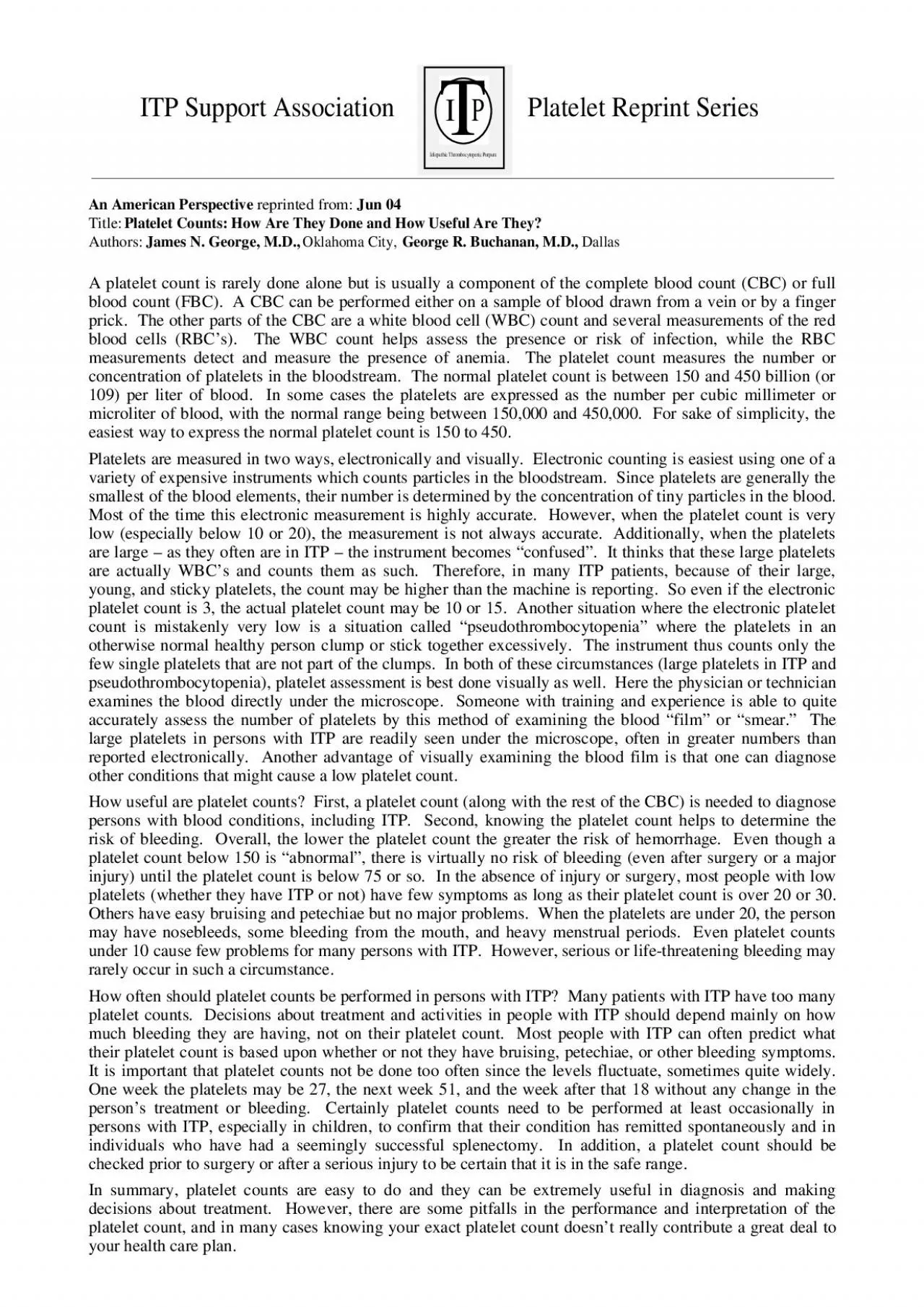/


a a a T I P Idiopathic Thrombocytopenic Purpura ID: 941531
Download Pdf The PPT/PDF document "ITP Support AssociationPlatelet Reprint ..." is the property of its rightful owner. Permission is granted to download and print the materials on this web site for personal, non-commercial use only, and to display it on your personal computer provided you do not modify the materials and that you retain all copyright notices contained in the materials. By downloading content from our website, you accept the terms of this agreement.
ITP Support AssociationPlatelet Reprint SeriesAn American Perspective reprinted from: Jun 04Title: Platelet Counts: How Are They Done and How Useful Are They?Authors: James N. George, M.D., Oklahoma City, George R. Buchanan, M.D., DallasA platelet count is rarely done alone but is usually a component of the complete blood count (CBC) or fullblood count (FBC). A CBC can be performed either on a sample of blood drawn from a vein or by a fingerprick. The other parts of the CBC are a white blood cell (WBC) count and several measurements of the redblood cells (RBCÕs). The WBC count helps assess the presence or risk of infection, while the RBCmeasurements detect and measure the presence of anemia. The platelet count measures the number orconcentration of platelets in the bloodstream. The normal platelet count is between 150 and 450 billion (or109) per liter of blood. In some cases the platelets are expressed as the number per cubic millimeter ormicroliter of blood, with the normal range being between 150,000 and 450,000. For sake of simplicity, theeasiest way to express the normal platelet count is 150 to 450.Platelets are measured in two ways, electronically and visually. Electronic counting is easiest using one of avariety of expensive instruments which counts particles in the bloodstream. Since platelets are generally thesmallest of the blood elements, their number is determined by the concentration of tiny particles in the blood.Most of the time this electronic measurement is highly accurate. However, when the platelet count is verylow (especially below 10 or 20), the measurement is not always accurate. Additionally, when the plateletsare large Ð as they often are in ITP Ð the instrument becomes ÒconfusedÓ. It thinks that these large plateletsare actually WBCÕs and counts them as such. Therefore, in many ITP patients, because of their large,young, and sticky platelets, the count may be higher than the machine is reporting. So even if the electronicplatelet count is 3, the actual platelet count may be 10 or 15. Another situation where the electronic plateletcount is mistakenly very low is a situation called ÒpseudothrombocytopeniaÓ where the platelets in anotherwise normal healthy person clump or stick together excessively. The instrument thus counts only thefew single platelets that are not part of the clumps. In both of these circumstances (large platelets in ITP andpseudothrombocytopenia), platelet assessment is best done visually as well. Here the physician or technicianexamines the blood directly under the microscope. Someone with training and experience is able to quiteaccurately assess the number of platelets by this method of examining the blood ÒfilmÓ or Òsmear.Ó Thelarge platelets in persons with ITP are readily seen under the microscope, often in greater numbers thanreported electronically. Another advantage of visually examining the blood film is that one can diagnoseother conditions that might cause a low platelet count.How useful are platelet counts? First, a platelet count (along with the rest of the CBC) is needed to diagnosepersons with blood conditions, including ITP. Second, knowing the platelet count helps to determine therisk of bleeding. Overall, the lower the platelet count the greater the risk of hemorrhage. Even though aplatelet count below 150 is ÒabnormalÓ, there is virtually no risk of bleeding (even after surgery or a majorinjury) until the platelet count is below 75 or so. In the absence of injury or surgery, most people with lowplatelets (whether they have ITP or not) have few symptoms as long as their platelet count is over 20 or 30.Others have easy bruising and petechiae but no major problems. When the platelets are under 20, the personmay have nosebleeds, some bleeding from the mouth, and heavy menstrual periods. Even platelet countsunder 10 cause few problems for many persons with ITP. However, serious or life-threatening bleeding mayrarely occur in such a circumstance.How often should platelet counts be performed in persons with ITP? Many patients with ITP have too manyplatelet counts. Decisions about treatment and activities in people with ITP should depend mainly on howmuch bleeding they are having, not on their platelet count. Most people with ITP can often predict whattheir platelet count is based upon whether or not they have bruising, petechiae, or other bleeding symptoms.It is important that platelet counts not be done too often since the levels fluctuate, sometimes quite widely.One week the platelets may be 27, the next week 51, and the week after that 18 without any change in thepersonÕs treatment or bleeding. Certainly platelet counts need to be performed at least occasionally inpersons with ITP, especially in children, to confirm that their condition has remitted spontaneously and inindividuals who have had a seemingly successful splenectomy. In addition, a platelet count should bechecked prior to surgery or after a serious injury to be certain that it is in the safe range.In summary, platelet counts are easy to do and they can be extremely useful in diagnosis and makingdecisions about treatment. However, there are some pitfalls in the performance and interpretation of theplatelet count, and in many cases knowing your exact platelet count doesnÕt really contribute a great deal toyour health care plan. a a a T I P Idiopathic Thrombocytopenic Purpura